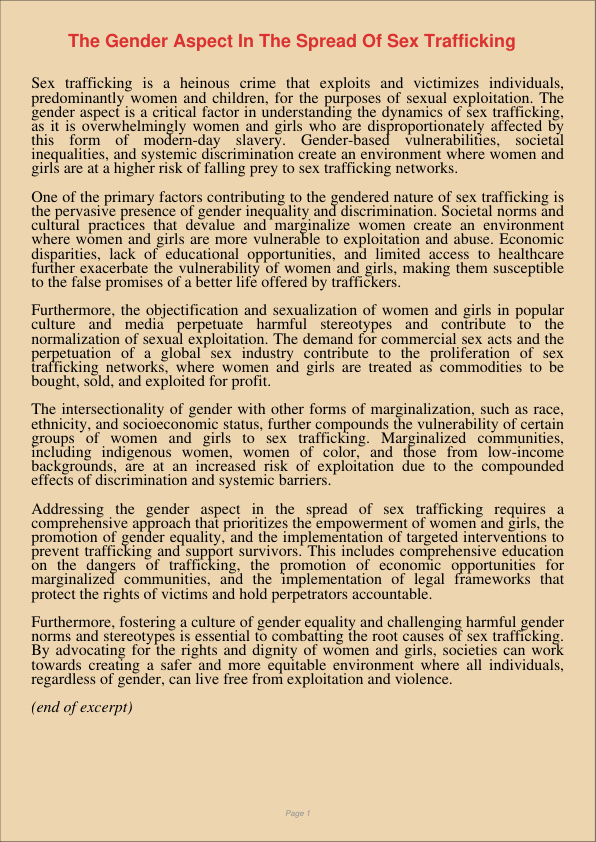The Gender Aspect In The Spread Of Sex Trafficking
Dec 31, 2023
sex trafficking
gender aspect
Visual Arts & Film Studies
Other
Sex trafficking is a heinous crime that exploits and victimizes individuals, predominantly women and children, for the purposes of sexual exploitation. The gender aspect is a critical factor in understanding the dynamics of sex trafficking, as it is overwhelmingly women and girls who are disproportionately affected by this form of modern-day slavery. Gender-based vulnerabilities, societal inequalities, and systemic discrimination create an environment where women and girls are at a higher risk of falling prey to sex trafficking networks.
One of the primary factors contributing to the gendered nature of sex trafficking is the pervasive presence of gender inequality and discrimination. Societal norms and cultural practices that devalue and marginalize women create an environment where women and girls are more vulnerable to exploitation and abuse. Economic disparities, lack of educational opportunities, and limited access to healthcare further exacerbate the vulnerability of women and girls, making them susceptible to the false promises of a better life offered by traffickers.
Furthermore, the objectification and sexualization of women and girls in popular culture and media perpetuate harmful stereotypes and contribute to the normalization of sexual exploitation. The demand for commercial sex acts and the perpetuation of a global sex industry contribute to the proliferation of sex trafficking networks, where women and girls are treated as commodities to be bought, sold, and exploited for profit.
The intersectionality of gender with other forms of marginalization, such as race, ethnicity, and socioeconomic status, further compounds the vulnerability of certain groups of women and girls to sex trafficking. Marginalized communities, including indigenous women, women of color, and those from low-income backgrounds, are at an increased risk of exploitation due to the compounded effects of discrimination and systemic barriers.
Addressing the gender aspect in the spread of sex trafficking requires a comprehensive approach that prioritizes the empowerment of women and girls, the promotion of gender equality, and the implementation of targeted interventions to prevent trafficking and support survivors. This includes comprehensive education on the dangers of trafficking, the promotion of economic opportunities for marginalized communities, and the implementation of legal frameworks that protect the rights of victims and hold perpetrators accountable.
Furthermore, fostering a culture of gender equality and challenging harmful gender norms and stereotypes is essential to combatting the root causes of sex trafficking. By advocating for the rights and dignity of women and girls, societies can work towards creating a safer and more equitable environment where all individuals, regardless of gender, can live free from exploitation and violence.
